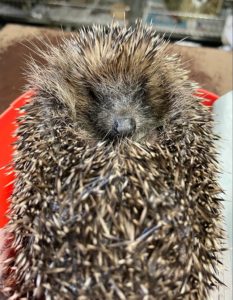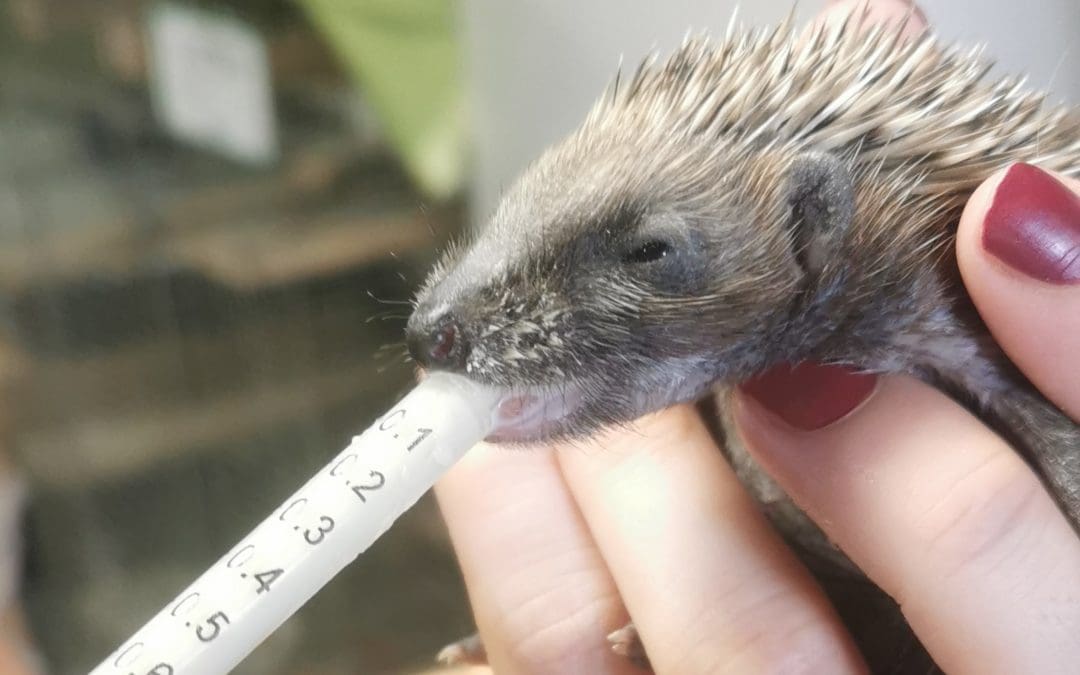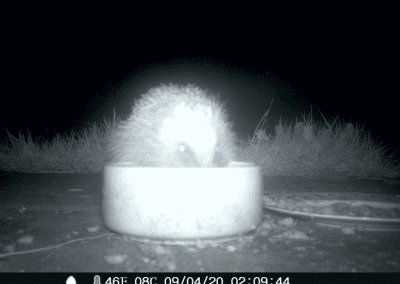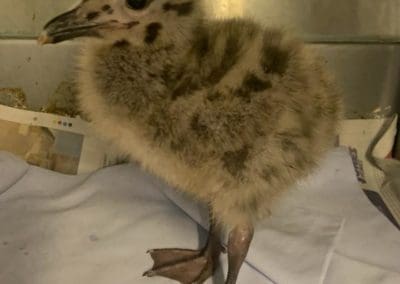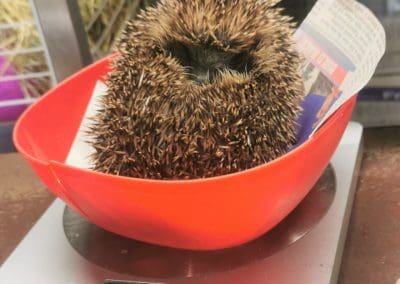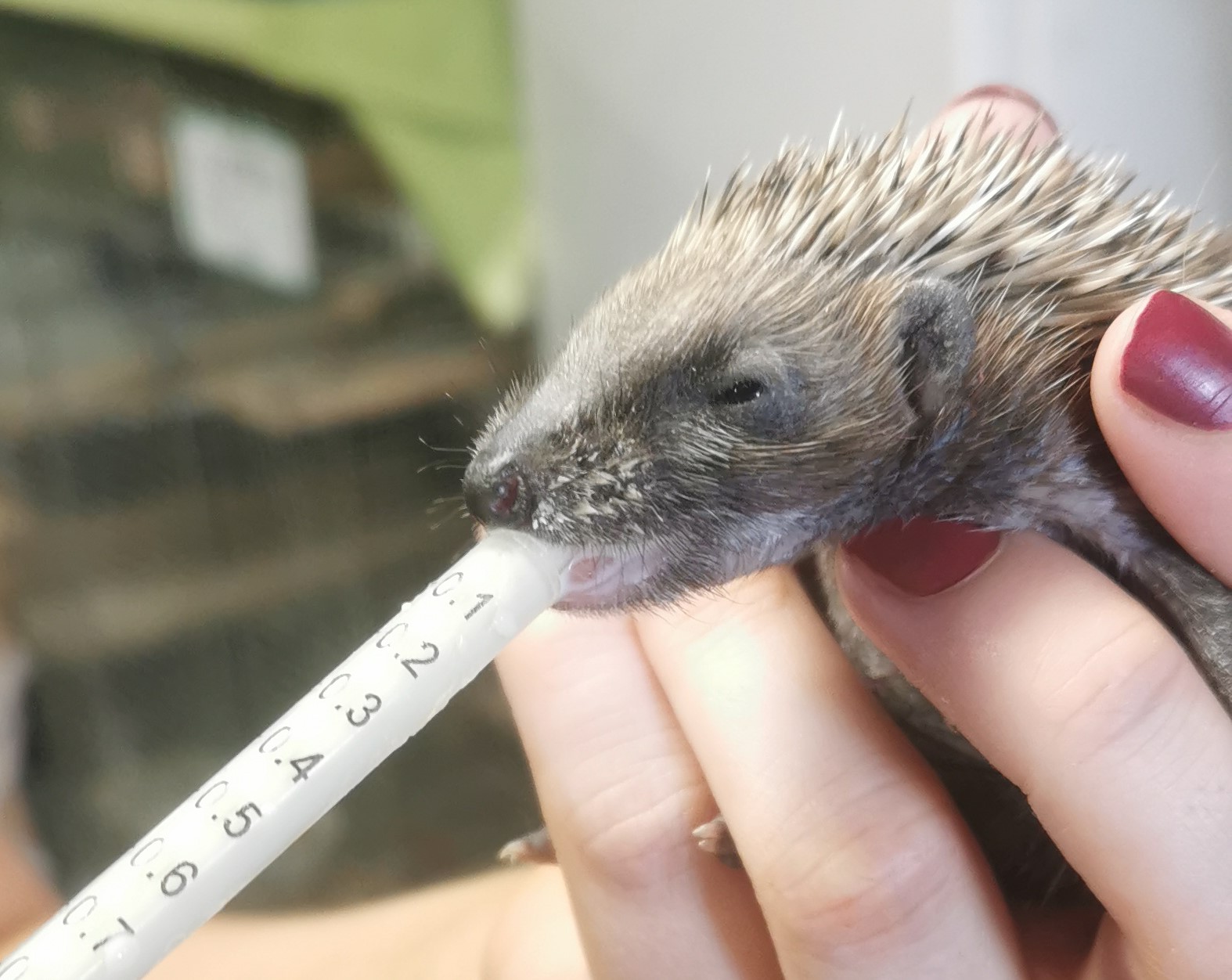
This month, we have had another 50+ wild animals admitted to our wildlife unit. The staff have been up at all hours of the night, hand feeding hedgehogs and birds – this is such a tiring and emotional job but working to save innocent lives is always worth it.
Hedgehogs usually give birth around June-July, so please make sure you are not disturbing any hedgehogs’ nests – if a nest is disturbed, mum may abandon or kill her babies. If you do accidently disturb a hedgehog nest cover it back up straight away – do not touch the hedgehogs. If you have found some baby hedgehogs without mum, wait and see if mum returns. If she does not, then contact a wildlife rescue centre for advice.
These hedgehogs, below, were brought into us this week, after their nest had been relocated. Luckily, they were checked on and it was found that mum had abandoned the babies after the nest was moved. They are now being hand reared, and we will do our best to help these little ones survive.
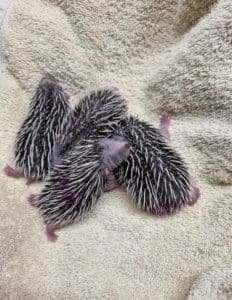
Remember a hedgehog nest is not always sturdy, it could just be a pile of leaves at the bottom of your garden.
Out and about in June
It’s very rare to see a mole, but if you check around mole hills now you just may see a baby mole temporarily above ground searching for its own territory.
Most bats are giving birth now, usually to a single pup, but compared to the mother, the pup is huge. Given that common and soprano pipistrelles, the UK’s two most abundant species of bat, weigh about the same as a 20p piece, this is comparable to a woman giving birth to a five-year-old. Nursing bats gather in single sex maternity roosts, and often occupy buildings with warm, south facing roofs.
Compared to the grass snake and adder, our third native snake, the smooth snake is small, slow, secretive and likes to hide in dense clumps of heather. Not only is its best distinguishing feature it’s smoothness, but also a dark smudge on the top of it’s head.
In summer, this snake divides its time between basking and hunting lizards, which it kills by squeezing, like a mini boa constrictor. Currently there is a new push to map and protect its last UK strongholds in Dorset, Hampshire and Surrey.
Grasslands are filling with the short, rattling song of the meadow grasshopper this month, with chorus lines formed by groups of males vying for the attention of the females.
Meadow grasshoppers are one of our most widespread species and also one of the first to reach adulthood, following a series of incremental nymph stages, known as instars. The early hatching of meadow grasshopper eggs can be triggered by warm spring temperatures, and climate change may lead to premature emergence becoming more common.
Although meadow grasshoppers are usually green, they are one of several species that can produce vivid pink individuals, a phenomenon known as erythrism.
The water shrew is one of our most mysterious mammals. June is said to be when the female gives birth, though the species’ exceptional shyness and preference for well-vegetated ponds and ditches means sightings are rare. (Many reports are recordings of its ultrasonic squeaks, picked up by bat detectors.)
The water shrew’s many adaptations to an aquatic life include a hairy tail and extra dense fur for buoyancy, and hairy feet for swimming. It is carnivorous, unlike the shoot-nibbling water vole and this is where its two secret weapons come in handy. The enamel in its red-tipped teeth is strengthened with iron, and it has venomous saliva potent enough to subdue small fish and frogs.
Southern hawkers are large dragonflies which emerge from ponds as adults from June onwards. You may see them flying right through into the autumn if the weather is good enough.
They are a common dragonfly of ponds, lakes and canals, particularly near to woodland. Hawkers are the largest and fastest flying dragonflies; they hover, catch their insect prey mid-air, and can even fly backwards!
Now is the time to look out for stag beetles flying around on warm evenings. These are one of our largest beetles. They’re named after the males’ large jaws, which are said to resemble the antlers of a stag.
The adults are short-lived (no more than a couple of months) but their larvae spend several years hidden underground where they feed on rotting wood. Look for them on woodland edges, in hedgerows, parks and gardens.
Masses of frothy white flowerheads cover elder trees in June. The flowers provide nectar for a variety of insects, and their sweet scent is unmistakable as you walk past. Later in the year the masses of dark berries are eaten by birds and small mammals.
It was once believed that elder trees were feared by the devil and warded off evil spirits or witches, so they were planted near houses to keep the occupants safe.
Elder flowers and berries are the only parts of the tree that are edible.
Only a quarter of Britain’s 40 or so slug species eat garden plants. Some of those, including black slugs, prefer rotting material, so are happier in compost heaps. By recycling nutrients, they play a key part in healthy ecosystems.
Black slugs are attractive (some can be orange or brown) with a beautifully grooved body often offset by a frilly orange ‘skirt’. We may as well admire these 150-million-year-old, one-footed hermaphrodites, and leave it to frogs, beetles and hedgehogs to control their numbers.
Did you Know…
Snakes can predict earthquakes.
Many animals are able to predict earthquakes to varying levels of success. Yet, snakes are the most reliable, sensing earthquakes from as far as 75 miles away (121 km). What’s more impressive is that they can sense an earthquake as many as five days before it actually occurs! When snakes sense an earthquake, they often leave their nests, even if the temperature is too cold.
Crows often hold grudges against specific people.
Crows are excellent at recognizing peoples’ faces and are able to remember people for a long time. This can be either a negative or positive fact, depending on how nice you are to them. While crows can tell us apart, we would find it difficult to distinguish one crow from another.
If you lift a kangaroo’s tail off the ground, it can’t hop.
Kangaroos use their tails for balance while hopping. So, if you elevate their tail, they lose their balance and fall over. There are cases where kangaroos have lost their tails and can still move around, but it took them a long time to adjust, and they can only move small distances at a time! Their tails aren’t only for balance they also act as a third leg, propelling them forward just as much as their legs do.
Please remember to…
Support wildlife at this time of the year, by putting food and water out for breeding birds and other wildlife such as hedgehogs, especially during dry periods. Dried cat or dog biscuits are ideal for hedgehogs, but avoid fish flavours. Please don’t put milk out for hedgehogs as they are lactose intolerant.
Please keep pets indoors if fledglings are on the ground. Their parents will be close and will still be feeding them.
Providing shallow saucers filled with water and small stones are ideal for insects to drink from.
Please remove rubbish from your gardens or local area to prevent wildlife from injury.
And Finally…
Always seek advice from wildlife staff before bringing an animal to the rescue. If an animal is injured, please take it to a vet as we don’t always have a vet on site.

Merchandise

Freshfields Lottery
